Cultural Policy, Power Dynamics, and the Influence of Garnham's Work
VerifiedAdded on 2023/06/06
|6
|1545
|68
Essay
AI Summary
This essay provides a critical analysis of cultural policy and power dynamics, primarily focusing on the work of Nicholas Garnham. It explores Garnham's identification of the mobilization of "creative industries" and its impact on economic growth, national development, and the integration of industrial activities with technology. The essay also discusses how Garnham's work has influenced various concepts, including the relationship between culture and political economy, the incorporation of cultural concepts in education, and the development of strategies for economic development. Furthermore, it examines other theoretical approaches, such as Richard Florida's concept of the "creative class" and the role of creativity in modern economies. The essay concludes by highlighting the importance of cultural policy and education in fostering creativity and innovation in industries, emphasizing the need for governments and educational institutions to adapt to the evolving landscape of the global, economic, and informational society. Desklib provides access to similar essays and study resources for students.
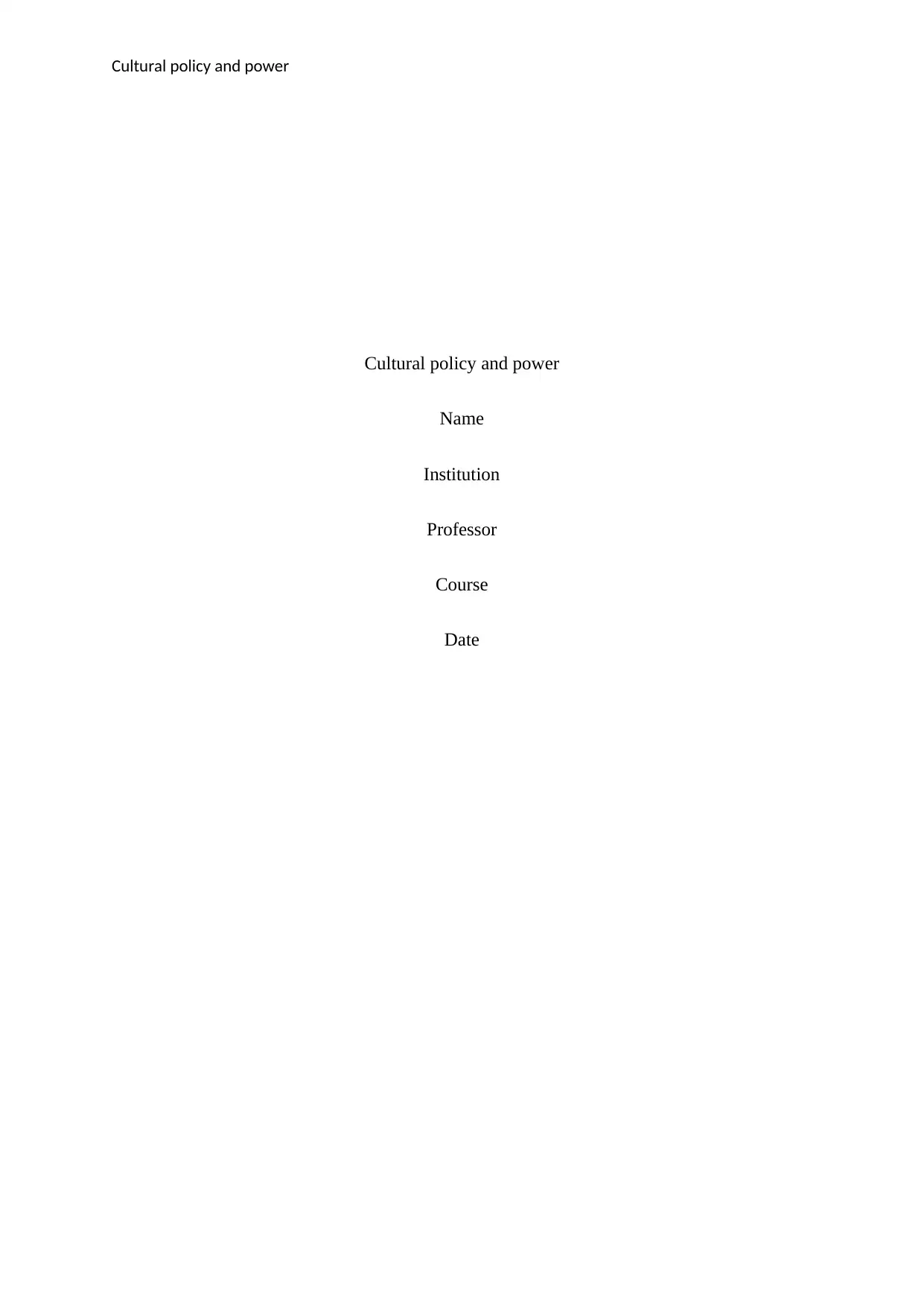
Cultural policy and power
Cultural policy and power
Name
Institution
Professor
Course
Date
Cultural policy and power
Name
Institution
Professor
Course
Date
Paraphrase This Document
Need a fresh take? Get an instant paraphrase of this document with our AI Paraphraser
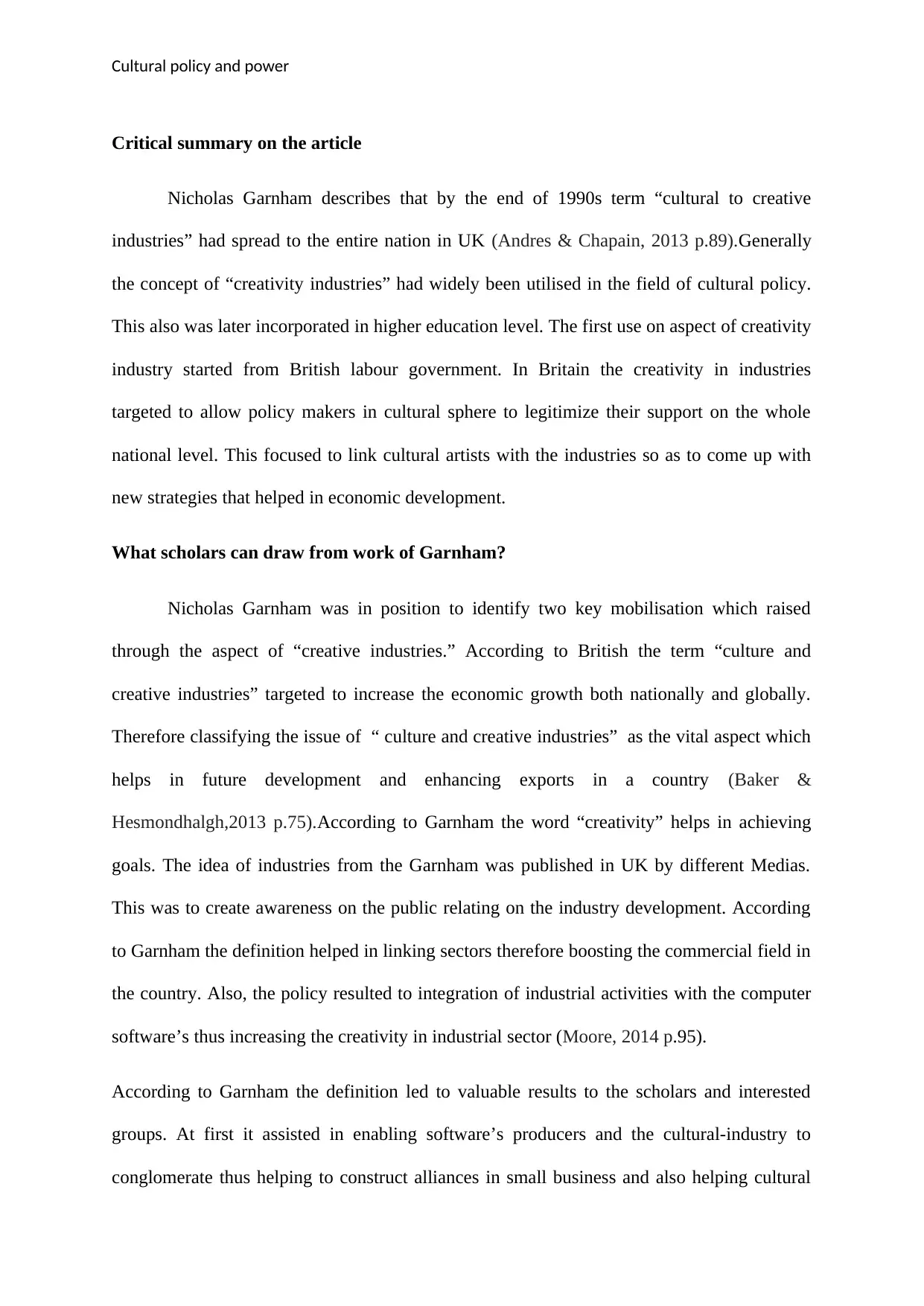
Cultural policy and power
Critical summary on the article
Nicholas Garnham describes that by the end of 1990s term “cultural to creative
industries” had spread to the entire nation in UK (Andres & Chapain, 2013 p.89).Generally
the concept of “creativity industries” had widely been utilised in the field of cultural policy.
This also was later incorporated in higher education level. The first use on aspect of creativity
industry started from British labour government. In Britain the creativity in industries
targeted to allow policy makers in cultural sphere to legitimize their support on the whole
national level. This focused to link cultural artists with the industries so as to come up with
new strategies that helped in economic development.
What scholars can draw from work of Garnham?
Nicholas Garnham was in position to identify two key mobilisation which raised
through the aspect of “creative industries.” According to British the term “culture and
creative industries” targeted to increase the economic growth both nationally and globally.
Therefore classifying the issue of “ culture and creative industries” as the vital aspect which
helps in future development and enhancing exports in a country (Baker &
Hesmondhalgh,2013 p.75).According to Garnham the word “creativity” helps in achieving
goals. The idea of industries from the Garnham was published in UK by different Medias.
This was to create awareness on the public relating on the industry development. According
to Garnham the definition helped in linking sectors therefore boosting the commercial field in
the country. Also, the policy resulted to integration of industrial activities with the computer
software’s thus increasing the creativity in industrial sector (Moore, 2014 p.95).
According to Garnham the definition led to valuable results to the scholars and interested
groups. At first it assisted in enabling software’s producers and the cultural-industry to
conglomerate thus helping to construct alliances in small business and also helping cultural
Critical summary on the article
Nicholas Garnham describes that by the end of 1990s term “cultural to creative
industries” had spread to the entire nation in UK (Andres & Chapain, 2013 p.89).Generally
the concept of “creativity industries” had widely been utilised in the field of cultural policy.
This also was later incorporated in higher education level. The first use on aspect of creativity
industry started from British labour government. In Britain the creativity in industries
targeted to allow policy makers in cultural sphere to legitimize their support on the whole
national level. This focused to link cultural artists with the industries so as to come up with
new strategies that helped in economic development.
What scholars can draw from work of Garnham?
Nicholas Garnham was in position to identify two key mobilisation which raised
through the aspect of “creative industries.” According to British the term “culture and
creative industries” targeted to increase the economic growth both nationally and globally.
Therefore classifying the issue of “ culture and creative industries” as the vital aspect which
helps in future development and enhancing exports in a country (Baker &
Hesmondhalgh,2013 p.75).According to Garnham the word “creativity” helps in achieving
goals. The idea of industries from the Garnham was published in UK by different Medias.
This was to create awareness on the public relating on the industry development. According
to Garnham the definition helped in linking sectors therefore boosting the commercial field in
the country. Also, the policy resulted to integration of industrial activities with the computer
software’s thus increasing the creativity in industrial sector (Moore, 2014 p.95).
According to Garnham the definition led to valuable results to the scholars and interested
groups. At first it assisted in enabling software’s producers and the cultural-industry to
conglomerate thus helping to construct alliances in small business and also helping cultural
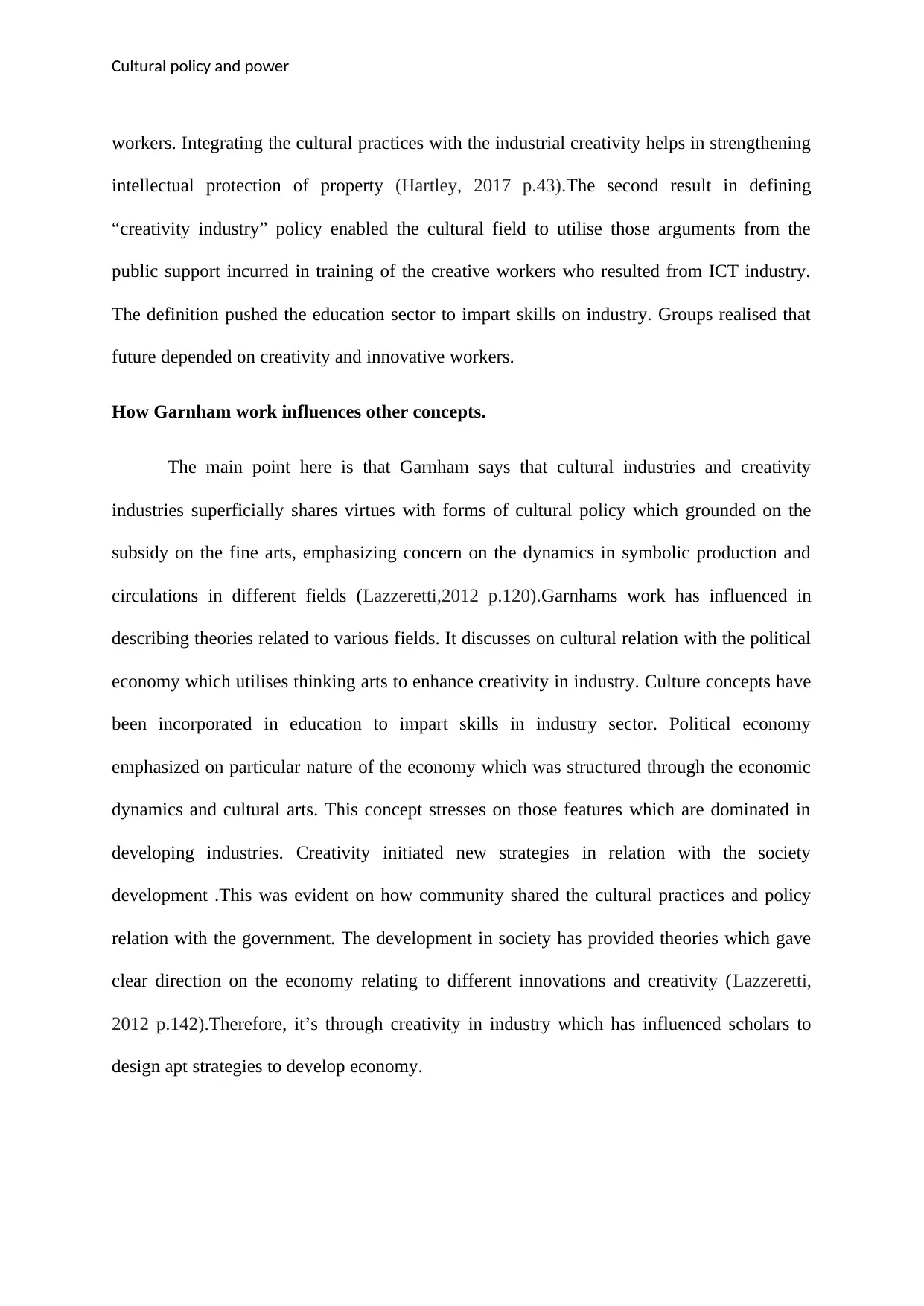
Cultural policy and power
workers. Integrating the cultural practices with the industrial creativity helps in strengthening
intellectual protection of property (Hartley, 2017 p.43).The second result in defining
“creativity industry” policy enabled the cultural field to utilise those arguments from the
public support incurred in training of the creative workers who resulted from ICT industry.
The definition pushed the education sector to impart skills on industry. Groups realised that
future depended on creativity and innovative workers.
How Garnham work influences other concepts.
The main point here is that Garnham says that cultural industries and creativity
industries superficially shares virtues with forms of cultural policy which grounded on the
subsidy on the fine arts, emphasizing concern on the dynamics in symbolic production and
circulations in different fields (Lazzeretti,2012 p.120).Garnhams work has influenced in
describing theories related to various fields. It discusses on cultural relation with the political
economy which utilises thinking arts to enhance creativity in industry. Culture concepts have
been incorporated in education to impart skills in industry sector. Political economy
emphasized on particular nature of the economy which was structured through the economic
dynamics and cultural arts. This concept stresses on those features which are dominated in
developing industries. Creativity initiated new strategies in relation with the society
development .This was evident on how community shared the cultural practices and policy
relation with the government. The development in society has provided theories which gave
clear direction on the economy relating to different innovations and creativity (Lazzeretti,
2012 p.142).Therefore, it’s through creativity in industry which has influenced scholars to
design apt strategies to develop economy.
workers. Integrating the cultural practices with the industrial creativity helps in strengthening
intellectual protection of property (Hartley, 2017 p.43).The second result in defining
“creativity industry” policy enabled the cultural field to utilise those arguments from the
public support incurred in training of the creative workers who resulted from ICT industry.
The definition pushed the education sector to impart skills on industry. Groups realised that
future depended on creativity and innovative workers.
How Garnham work influences other concepts.
The main point here is that Garnham says that cultural industries and creativity
industries superficially shares virtues with forms of cultural policy which grounded on the
subsidy on the fine arts, emphasizing concern on the dynamics in symbolic production and
circulations in different fields (Lazzeretti,2012 p.120).Garnhams work has influenced in
describing theories related to various fields. It discusses on cultural relation with the political
economy which utilises thinking arts to enhance creativity in industry. Culture concepts have
been incorporated in education to impart skills in industry sector. Political economy
emphasized on particular nature of the economy which was structured through the economic
dynamics and cultural arts. This concept stresses on those features which are dominated in
developing industries. Creativity initiated new strategies in relation with the society
development .This was evident on how community shared the cultural practices and policy
relation with the government. The development in society has provided theories which gave
clear direction on the economy relating to different innovations and creativity (Lazzeretti,
2012 p.142).Therefore, it’s through creativity in industry which has influenced scholars to
design apt strategies to develop economy.
⊘ This is a preview!⊘
Do you want full access?
Subscribe today to unlock all pages.

Trusted by 1+ million students worldwide
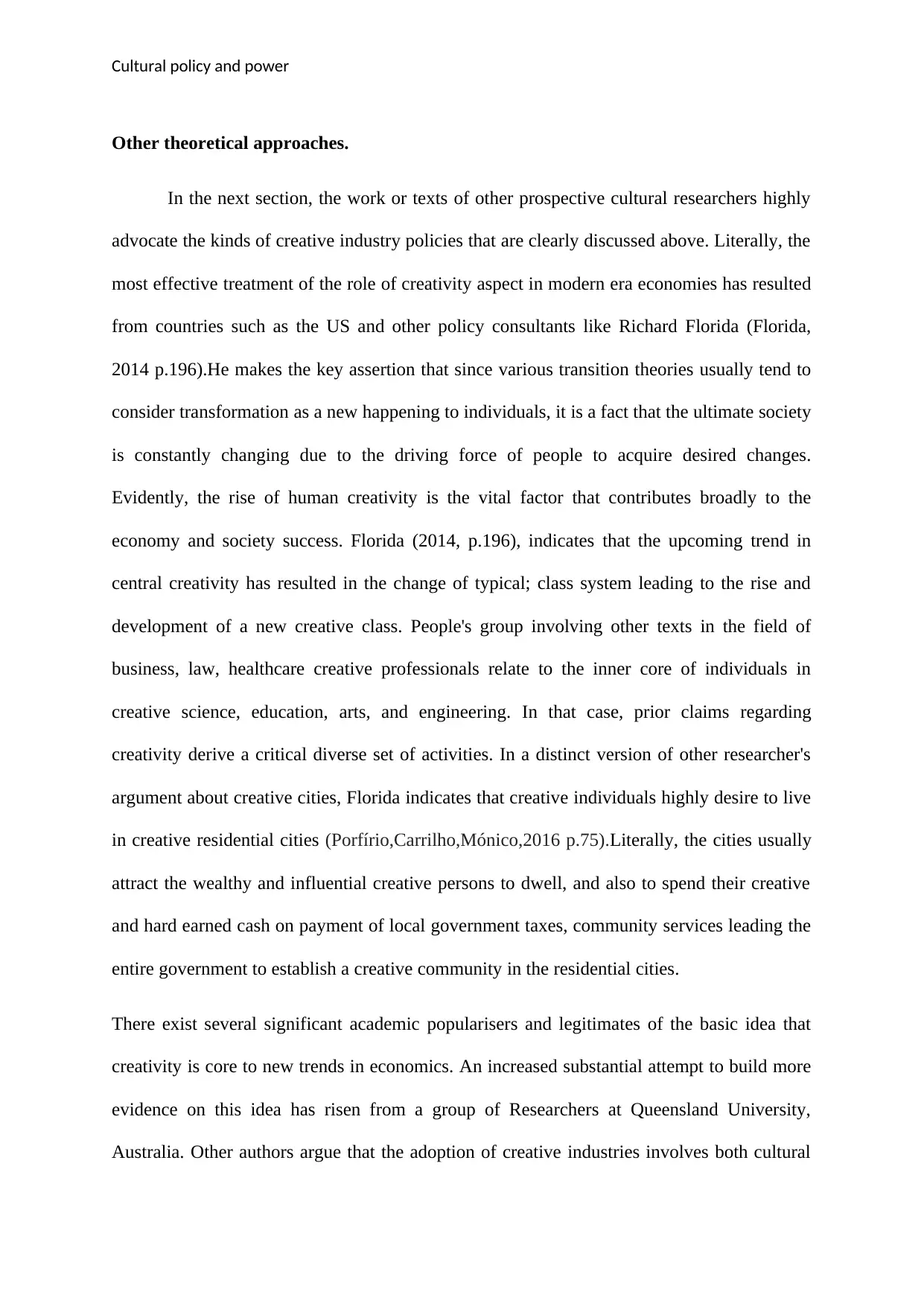
Cultural policy and power
Other theoretical approaches.
In the next section, the work or texts of other prospective cultural researchers highly
advocate the kinds of creative industry policies that are clearly discussed above. Literally, the
most effective treatment of the role of creativity aspect in modern era economies has resulted
from countries such as the US and other policy consultants like Richard Florida (Florida,
2014 p.196).He makes the key assertion that since various transition theories usually tend to
consider transformation as a new happening to individuals, it is a fact that the ultimate society
is constantly changing due to the driving force of people to acquire desired changes.
Evidently, the rise of human creativity is the vital factor that contributes broadly to the
economy and society success. Florida (2014, p.196), indicates that the upcoming trend in
central creativity has resulted in the change of typical; class system leading to the rise and
development of a new creative class. People's group involving other texts in the field of
business, law, healthcare creative professionals relate to the inner core of individuals in
creative science, education, arts, and engineering. In that case, prior claims regarding
creativity derive a critical diverse set of activities. In a distinct version of other researcher's
argument about creative cities, Florida indicates that creative individuals highly desire to live
in creative residential cities (Porfírio,Carrilho,Mónico,2016 p.75).Literally, the cities usually
attract the wealthy and influential creative persons to dwell, and also to spend their creative
and hard earned cash on payment of local government taxes, community services leading the
entire government to establish a creative community in the residential cities.
There exist several significant academic popularisers and legitimates of the basic idea that
creativity is core to new trends in economics. An increased substantial attempt to build more
evidence on this idea has risen from a group of Researchers at Queensland University,
Australia. Other authors argue that the adoption of creative industries involves both cultural
Other theoretical approaches.
In the next section, the work or texts of other prospective cultural researchers highly
advocate the kinds of creative industry policies that are clearly discussed above. Literally, the
most effective treatment of the role of creativity aspect in modern era economies has resulted
from countries such as the US and other policy consultants like Richard Florida (Florida,
2014 p.196).He makes the key assertion that since various transition theories usually tend to
consider transformation as a new happening to individuals, it is a fact that the ultimate society
is constantly changing due to the driving force of people to acquire desired changes.
Evidently, the rise of human creativity is the vital factor that contributes broadly to the
economy and society success. Florida (2014, p.196), indicates that the upcoming trend in
central creativity has resulted in the change of typical; class system leading to the rise and
development of a new creative class. People's group involving other texts in the field of
business, law, healthcare creative professionals relate to the inner core of individuals in
creative science, education, arts, and engineering. In that case, prior claims regarding
creativity derive a critical diverse set of activities. In a distinct version of other researcher's
argument about creative cities, Florida indicates that creative individuals highly desire to live
in creative residential cities (Porfírio,Carrilho,Mónico,2016 p.75).Literally, the cities usually
attract the wealthy and influential creative persons to dwell, and also to spend their creative
and hard earned cash on payment of local government taxes, community services leading the
entire government to establish a creative community in the residential cities.
There exist several significant academic popularisers and legitimates of the basic idea that
creativity is core to new trends in economics. An increased substantial attempt to build more
evidence on this idea has risen from a group of Researchers at Queensland University,
Australia. Other authors argue that the adoption of creative industries involves both cultural
Paraphrase This Document
Need a fresh take? Get an instant paraphrase of this document with our AI Paraphraser
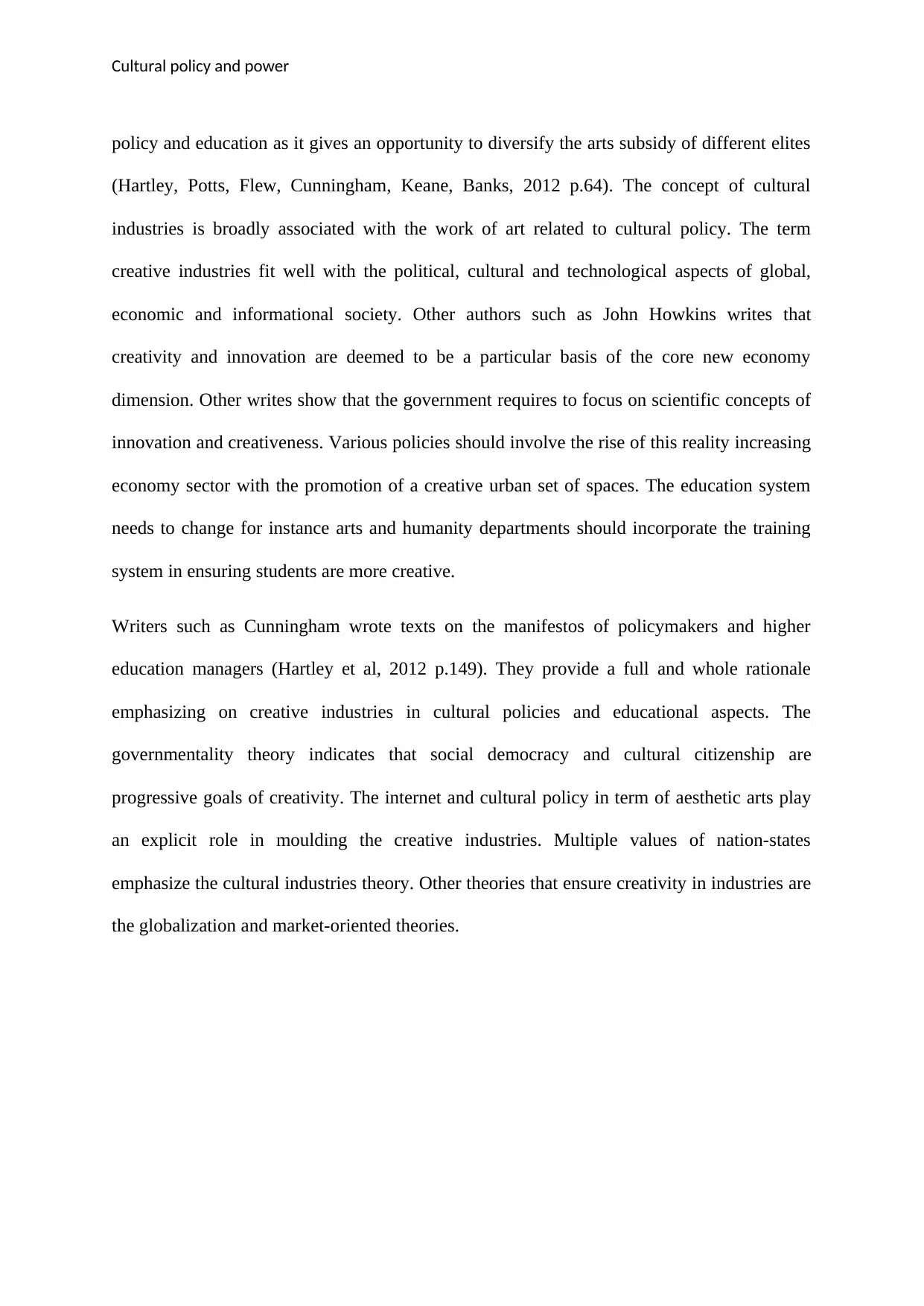
Cultural policy and power
policy and education as it gives an opportunity to diversify the arts subsidy of different elites
(Hartley, Potts, Flew, Cunningham, Keane, Banks, 2012 p.64). The concept of cultural
industries is broadly associated with the work of art related to cultural policy. The term
creative industries fit well with the political, cultural and technological aspects of global,
economic and informational society. Other authors such as John Howkins writes that
creativity and innovation are deemed to be a particular basis of the core new economy
dimension. Other writes show that the government requires to focus on scientific concepts of
innovation and creativeness. Various policies should involve the rise of this reality increasing
economy sector with the promotion of a creative urban set of spaces. The education system
needs to change for instance arts and humanity departments should incorporate the training
system in ensuring students are more creative.
Writers such as Cunningham wrote texts on the manifestos of policymakers and higher
education managers (Hartley et al, 2012 p.149). They provide a full and whole rationale
emphasizing on creative industries in cultural policies and educational aspects. The
governmentality theory indicates that social democracy and cultural citizenship are
progressive goals of creativity. The internet and cultural policy in term of aesthetic arts play
an explicit role in moulding the creative industries. Multiple values of nation-states
emphasize the cultural industries theory. Other theories that ensure creativity in industries are
the globalization and market-oriented theories.
policy and education as it gives an opportunity to diversify the arts subsidy of different elites
(Hartley, Potts, Flew, Cunningham, Keane, Banks, 2012 p.64). The concept of cultural
industries is broadly associated with the work of art related to cultural policy. The term
creative industries fit well with the political, cultural and technological aspects of global,
economic and informational society. Other authors such as John Howkins writes that
creativity and innovation are deemed to be a particular basis of the core new economy
dimension. Other writes show that the government requires to focus on scientific concepts of
innovation and creativeness. Various policies should involve the rise of this reality increasing
economy sector with the promotion of a creative urban set of spaces. The education system
needs to change for instance arts and humanity departments should incorporate the training
system in ensuring students are more creative.
Writers such as Cunningham wrote texts on the manifestos of policymakers and higher
education managers (Hartley et al, 2012 p.149). They provide a full and whole rationale
emphasizing on creative industries in cultural policies and educational aspects. The
governmentality theory indicates that social democracy and cultural citizenship are
progressive goals of creativity. The internet and cultural policy in term of aesthetic arts play
an explicit role in moulding the creative industries. Multiple values of nation-states
emphasize the cultural industries theory. Other theories that ensure creativity in industries are
the globalization and market-oriented theories.
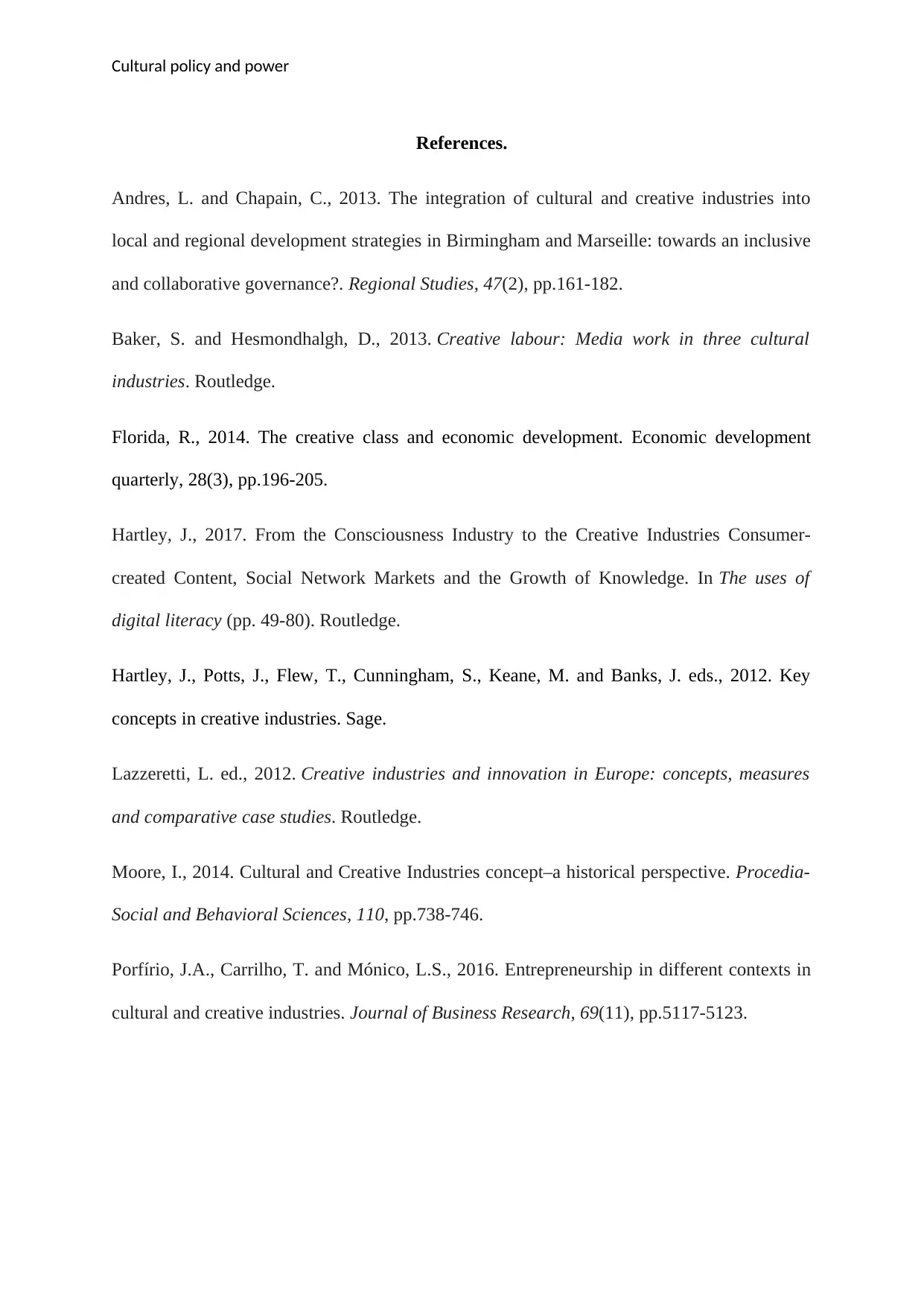
Cultural policy and power
References.
Andres, L. and Chapain, C., 2013. The integration of cultural and creative industries into
local and regional development strategies in Birmingham and Marseille: towards an inclusive
and collaborative governance?. Regional Studies, 47(2), pp.161-182.
Baker, S. and Hesmondhalgh, D., 2013. Creative labour: Media work in three cultural
industries. Routledge.
Florida, R., 2014. The creative class and economic development. Economic development
quarterly, 28(3), pp.196-205.
Hartley, J., 2017. From the Consciousness Industry to the Creative Industries Consumer-
created Content, Social Network Markets and the Growth of Knowledge. In The uses of
digital literacy (pp. 49-80). Routledge.
Hartley, J., Potts, J., Flew, T., Cunningham, S., Keane, M. and Banks, J. eds., 2012. Key
concepts in creative industries. Sage.
Lazzeretti, L. ed., 2012. Creative industries and innovation in Europe: concepts, measures
and comparative case studies. Routledge.
Moore, I., 2014. Cultural and Creative Industries concept–a historical perspective. Procedia-
Social and Behavioral Sciences, 110, pp.738-746.
Porfírio, J.A., Carrilho, T. and Mónico, L.S., 2016. Entrepreneurship in different contexts in
cultural and creative industries. Journal of Business Research, 69(11), pp.5117-5123.
References.
Andres, L. and Chapain, C., 2013. The integration of cultural and creative industries into
local and regional development strategies in Birmingham and Marseille: towards an inclusive
and collaborative governance?. Regional Studies, 47(2), pp.161-182.
Baker, S. and Hesmondhalgh, D., 2013. Creative labour: Media work in three cultural
industries. Routledge.
Florida, R., 2014. The creative class and economic development. Economic development
quarterly, 28(3), pp.196-205.
Hartley, J., 2017. From the Consciousness Industry to the Creative Industries Consumer-
created Content, Social Network Markets and the Growth of Knowledge. In The uses of
digital literacy (pp. 49-80). Routledge.
Hartley, J., Potts, J., Flew, T., Cunningham, S., Keane, M. and Banks, J. eds., 2012. Key
concepts in creative industries. Sage.
Lazzeretti, L. ed., 2012. Creative industries and innovation in Europe: concepts, measures
and comparative case studies. Routledge.
Moore, I., 2014. Cultural and Creative Industries concept–a historical perspective. Procedia-
Social and Behavioral Sciences, 110, pp.738-746.
Porfírio, J.A., Carrilho, T. and Mónico, L.S., 2016. Entrepreneurship in different contexts in
cultural and creative industries. Journal of Business Research, 69(11), pp.5117-5123.
⊘ This is a preview!⊘
Do you want full access?
Subscribe today to unlock all pages.

Trusted by 1+ million students worldwide
1 out of 6
Your All-in-One AI-Powered Toolkit for Academic Success.
+13062052269
info@desklib.com
Available 24*7 on WhatsApp / Email
![[object Object]](/_next/static/media/star-bottom.7253800d.svg)
Unlock your academic potential
Copyright © 2020–2025 A2Z Services. All Rights Reserved. Developed and managed by ZUCOL.
